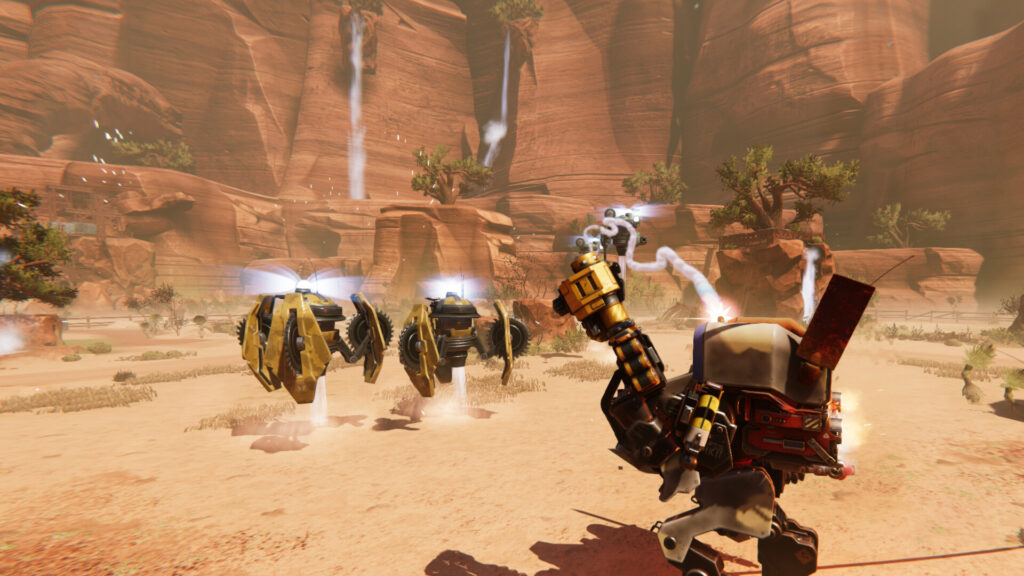Some concepts seem like they go together without much effort. A Wild West setting and story about redemption, but set in a post-apocalyptic world with mechs? Say less, I’m already there. Such a premise doesn’t need to be the most explosive. As Bounty Star showcases, one can take a more meditative approach, not unlike Wanderstop, another Annapurna Interactive-published title. However, while this development team doesn’t shy away from action, the overall execution reflects the moroseness of its subtitle more than anything else.
The story begins with Clementine McKinney, aka Clem, in far better circumstances. Part of a guard unit for the town of Short Spire, it suddenly comes under attack courtesy of outlaws led by Samuel Standage. After making short work of him, Clementine exercises mercy, pushing him to leave with his troops and never return; however, this leads to a double-cross, wherein the town – and Clem’s unit – are destroyed. Burying those who perished earns her the nickname “Graveyard Clem,” and she’s seemingly inert to the world afterwards.
“Oftentimes, you’re left waiting for calls to tackle new bounties, some higher risk than others and with their own unique backgrounds, but those don’t usually impact the overall mission (even if you decide to take them alive, when given the choice).”
That is, until former officer and friend Jake Triminy offers some bounty work for the mysterious Syndicate in the Red Expanse several months later. With nothing else to do and not wanting to die on an empty stomach, Clem accepts. Considering how such set-ups usually unfold, it’s interesting to see Bounty Star not immediately turn into a revenge saga. For her part, Clem feels dead to the world, even if she’s not keen on wasting away, but past events mean she’ll have to work her way up through the ranks, taking up low-risk marks until the Syndicate deems her worthy of tougher targets.
Slowly and slowly, she begins to come out of her shell, rediscovering the joy that outfitting and optimizing Raptors (the mechs in this universe) brings. However, she’s also cognizant that sinking further into the pilot’s seat means that more violence is coming her way, and the lawlessness of the Expanse isn’t something to take lightly.
The problem is that, aside from Clem’s own methodical development and inner thoughts, as depicted in her journal, there isn’t much driving the narrative of Bounty Star. Oftentimes, you’re left waiting for calls to tackle new bounties, some higher risk than others and with their own unique backgrounds, but those don’t usually impact the overall mission (even if you decide to take them alive, when given the choice). Throwing some no-good criminals behind bars does advance your rank, as Clem moves from a Prospect to a full-fledged Hunter worthy of her own Star, but their characters rarely rank above random mooks.
Besides Jake, characters like Utay offer some decent banter, but I’d be lying if I didn’t say Clem’s personality is what carries much of these exchanges. And even with that in mind, the writing does tend to become a little too cheesy – like when Clem tries to “talk” to her Raptor and figure out how to make it better, finds no answer and consults her stuffed dino Jeremy. At least the line, “You’ve once again demonstrated your genius by shuttin’ the hell up and lettin’ me be a genius,” is a cute bit of self-awareness.
“Unfortunately, combat as a whole can feel floaty and inconsistent. Follow-up melee hits feel like they trigger on their own sometimes, and dashing away to aim over the shoulder and fire some rounds mostly resulted in the Raptor performing a Trick attack instead.”
Aside from all this, Bounty Star falls short in the gameplay department. If you’re keen to stomp through the Expanse in a Freelancer-like fashion, stifle those hopes immediately. Every bounty takes you to a predetermined area with boundary walls – some offer more space and verticality than others, but for the most part, you’re going toe-to-toe with other Raptors, foot soldiers, flying drones and the occasional heavy. Combat involves multiple weapon types, each offering significant advantages depending on the enemy. This is further diversified into Ranged and Melee resistance, so even if you have the matching firearm, getting up close and personal is the only way to break through.
When you’re not slicing and dicing with a blade or an over-sized hammer in one hand, you’re riddling foes with assault rifle bullets or shotgun shells with the other. Swapping between the two feels seamless enough, and you can even unlock the ability to transition from a melee attack directly into a Trick attack that uses your firearm. It can manifest through a spinning spread of bullets or a leap backwards as you pummel foes with grenade launcher shots, but I found only one option that truly allowed for continuing a combo. So even if the shotgun felt good for chunking down heavier targets, it doesn’t necessarily transition well into my hammer combos.
Then there’s the whole system of managing your heat, which is influenced by the time of day. Afternoons lead to a higher base temperature overall, but this can be dealt with by using a support system that significantly cools you down with each dash. However, you can use low and high temps to your advantage, either improving firearm speed or melee speed, though it’s often better to avoid an overload.
Unfortunately, combat as a whole can feel floaty and inconsistent. Follow-up melee hits feel like they trigger on their own sometimes, and dashing away to aim over the shoulder and fire some rounds mostly resulted in the Raptor performing a Trick attack instead. Some interactions also feel unintentional – like leaping into the air with a Trick attack and then using the short boost to air-dash multiple times around an opponent like it’s Armored Core (but worse).
Enemies have some variety to them, including different combos depending on their weapons, but they’re let down by the repetitive mission objectives. Aside from capturing or killing a target, objectives boil down to destroying an environmental object, emerging unscathed, finishing the objective before the specified time, and finding a lost stash of Curios. Nothing particularly compelling, and despite the simplistic layout of some levels, finding that last propane tank to destroy feels like hunting a needle in a junkyard.
“If the combat felt more fluid or the missions offered more variety – heck, even if the story kept up with Clementine’s character development rather than serving as an accessory, Bounty Star could have stood out.”
The other major component of Bounty Star’s gameplay loop is the base-building, crafting and arming. However, these are extremely streamlined. I appreciate being able to directly buy materials from the shopping terminal without having to leave the crafting bench, but otherwise, setting up facilities, growing vegetables for ingredients, managing power – it all feels ridiculously surface-level, and I’m not expecting a survival crafting sandbox on the level of the genre’s current greats. Just something that demands more than simply pressing X to water the plants or sticking a battery into the power grid to power up a new function.
The difficulty does eventually increase, and some new weapons and upgrades for Clem to experiment with are introduced. The ability to swap between loadouts mid-mission is also a nice touch, nipping any concerns about restrictiveness due to damage types in the bud without completely removing any semblance of strategy.
However, Bounty Star’s overall cozy pace feels at odds with its gameplay loop, where repetitive activities lead to boredom more than relaxation. Even the side bounties begin to repeat, but you can’t pursue their optional objectives again for more cash. If the combat felt more fluid or the missions offered more variety – heck, even if the story kept up with Clementine’s character development rather than serving as an accessory, Bounty Star could have stood out. Instead, it teeters more towards sedative than contemplative on the regular.
This game was reviewed on PC.






